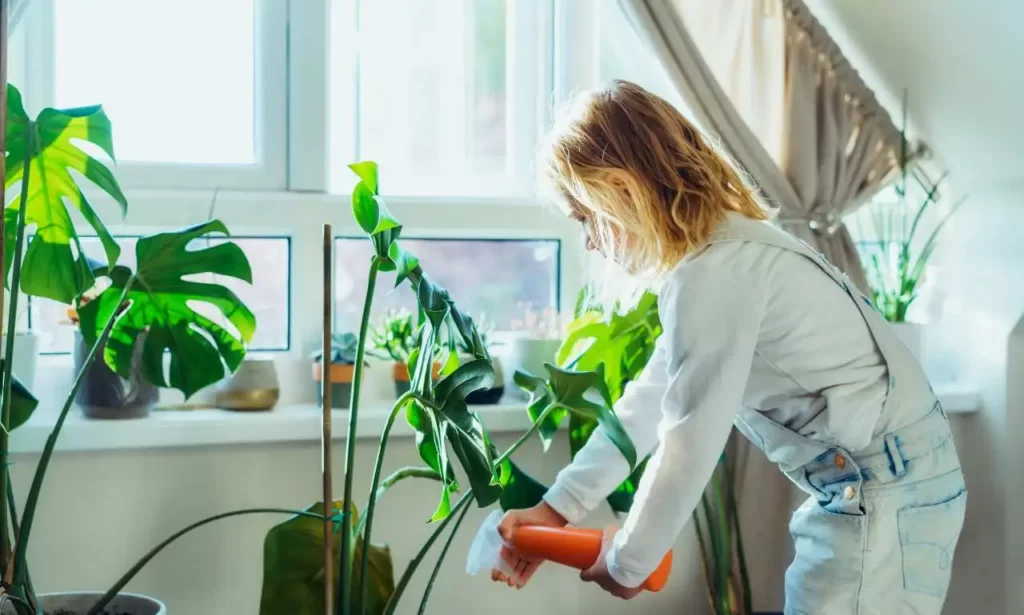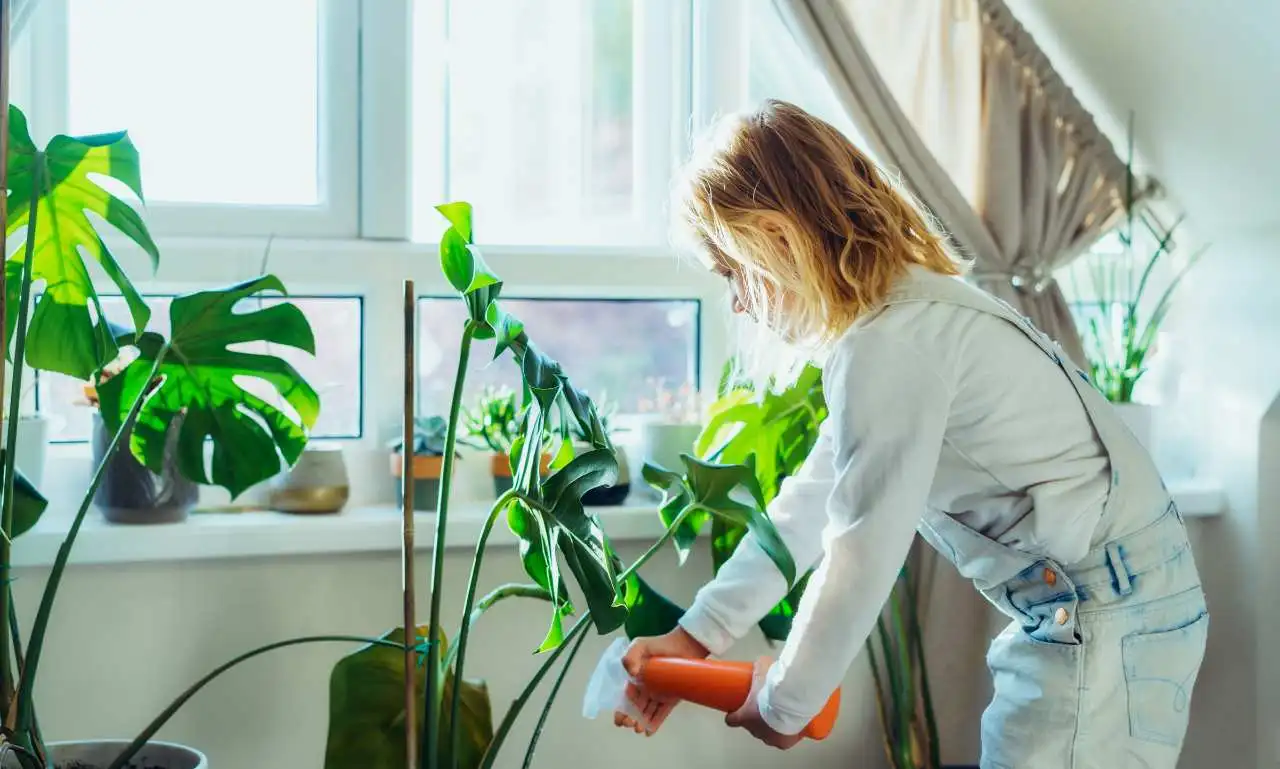In the world of indoor plants, few captivate the imagination quite like the Monstera deliciosa.
With its iconic split leaves reminiscent of tropical jungles, it has become a staple in many households and offices alike.
However, while this plant thrives in bright, indirect light, it’s essential to understand the delicate balance between light exposure and its well-being.
Today, we delve into the nuanced topic of “Monstera too much sun” – exploring its effects, problems, and solutions.

Table of Contents
Understanding Monstera’s Light Needs:
Before diving into the perils of excessive sunlight, let’s establish a foundational understanding of what Monstera deliciosa requires in terms of light.
Native to the rainforests of Central America, Monstera evolved under the dappled shade of towering trees.
This environment provides filtered sunlight, allowing the plant to thrive without being exposed to direct, harsh rays.
In its natural habitat, Monstera grows beneath the canopy, where it receives bright, indirect light.
This dappled sunlight, filtered through the tree leaves above, provides the perfect balance of energy for photosynthesis without overwhelming the plant.
When replicating these conditions indoors, it’s essential to mimic this environment as closely as possible.
Placing your Monstera near a window with sheer curtains or in a spot where it receives bright, indirect light for a few hours a day will promote healthy growth.
Also Read: Do Monsteras Like Humidity?
Monstera Too Much Sun Problems:
While Monstera deliciosa can tolerate some direct sunlight, prolonged exposure to intense rays can lead to a range of problems:
- Leaf Burn: Direct sunlight can cause sunburn on the leaves of Monstera deliciosa, manifesting as brown or yellow spots. This occurs when the sun’s rays become too intense, damaging the plant’s delicate foliage. Over time, severe leaf burn can weaken the plant and compromise its overall health.
- Dehydration: Excessive sunlight can also lead to rapid evaporation of moisture from the plant’s leaves, causing dehydration. Monstera deliciosa prefers humid environments, and prolonged exposure to intense sunlight can exacerbate dryness, leading to wilted, droopy foliage.
- Stunted Growth: While Monstera requires light for photosynthesis and growth, too much sunlight can have the opposite effect. Intense sunlight can stress the plant, diverting its energy away from growth and towards survival. As a result, you may notice slower growth or stunted development in Monstera exposed to excessive sunlight.
- Faded Leaves: Prolonged exposure to direct sunlight can also cause the vibrant green leaves of Monstera deliciosa to fade. The UV rays in sunlight can bleach the pigments in the leaves, resulting in a washed-out appearance. Faded leaves not only detract from the plant’s aesthetic appeal but can also indicate underlying stress.
- Root Damage: While we often focus on the effects of sunlight on the foliage, it’s essential to recognize its impact on the plant’s root system as well. Excessive heat from direct sunlight can raise the temperature of the soil, leading to root damage or even root rot in extreme cases. Healthy roots are crucial for the overall well-being of the plant, and prolonged exposure to intense sunlight can compromise their health.
Solutions and Mitigation Strategies:
Fortunately, there are several steps you can take to protect your Monstera deliciosa from the perils of excessive sunlight:
1. Optimal Placement:
Placing your Monstera in the right spot is crucial for its health and well-being. While it thrives in bright, indirect light, direct sunlight can be detrimental.
Optimal placement involves finding a balance where the plant receives adequate light without being exposed to harsh, direct rays.
North or east-facing windows are ideal, as they provide gentle morning sunlight that is less intense than afternoon sun.
Additionally, positioning your Monstera near windows with sheer curtains can help filter the sunlight, creating a more conducive environment for growth.
2. Rotate Regularly:
Rotating your Monstera regularly is a simple yet effective way to promote balanced growth and prevent sunburn on specific leaves.
By rotating the plant every few weeks, you ensure that all sides receive equal exposure to light, preventing uneven growth patterns.
This practice also allows you to monitor the plant’s health closely, as you can inspect each leaf for signs of damage or stress. Remember to rotate the plant gently to avoid disturbing the roots or causing unnecessary stress.
3. Use Sheer Curtains or Blinds:
If your Monstera is situated near windows with direct sunlight, using sheer curtains or blinds can help diffuse the light and protect the plant from excessive sun exposure.
Sheer curtains filter out the harsh rays while still allowing sufficient light for photosynthesis.
You can adjust the curtains or blinds throughout the day to regulate the amount of sunlight your Monstera receives, ensuring it remains within the optimal range for healthy growth.
Additionally, consider investing in UV-filtering window film to further reduce the intensity of sunlight.
4. Monitor Moisture Levels:
Proper hydration is essential for maintaining the health and vitality of your Monstera, especially when exposed to direct sunlight.
Keep a close eye on the moisture levels of the soil, ensuring it remains consistently moist but not waterlogged.
Water your plant regularly, allowing excess water to drain freely from the bottom of the pot to prevent waterlogging.
Consider using a moisture meter to accurately gauge soil moisture levels and adjust your watering schedule accordingly.
Additionally, placing a humidity tray filled with water near your Monstera can help maintain moisture in the air, creating a more humid microclimate that mimics its natural habitat.
5. Provide Adequate Shade:
During periods of intense sunlight, such as heatwaves or summer months, providing additional shade for your Monstera is crucial for its protection.
This could involve moving the plant to a shadier location indoors, away from direct sunlight, or creating makeshift shade using umbrellas, shade cloth, or plant stands.
Outdoor Monstera plants can benefit from being placed under trees or awnings to shield them from the sun’s harsh rays.
By providing adequate shade during peak sunlight hours, you can prevent leaf burn, dehydration, and other issues associated with excessive sunlight exposure.
By implementing these solutions and mitigation strategies, you can ensure that your Monstera remains healthy and vibrant, its lush foliage a testament to your care and attention to its light requirements.
Remember to observe your plant closely and make adjustments as needed to provide the optimal growing conditions for long-term success.
Conclusion
In the intricate dance between light and life, Monstera deliciosa occupies a delicate position. While it thrives in bright, indirect light, excessive sunlight can pose significant challenges to its well-being.
By understanding the problems associated with “Monstera too much sun” and implementing appropriate solutions, you can ensure that your plant continues to flourish, its lush foliage a testament to the careful balance of nature’s elements.
So, let your Monstera bask in the gentle glow of filtered sunlight, and watch as it transforms your space into a verdant oasis of tropical beauty.
Related FAQs:
How can I tell if my Monstera is getting too much sun?
Signs of excessive sunlight exposure in Monstera deliciosa include leaf burn, yellowing or browning of the leaves, wilting or drooping foliage, faded leaf color, and stunted growth.
If you notice any of these symptoms, it’s essential to assess the plant’s light exposure and make adjustments accordingly.
What should I do if my Monstera is experiencing leaf burn from too much sun?
If your Monstera is suffering from leaf burn due to excessive sunlight, take immediate action to mitigate further damage.
Move the plant to a shadier location away from direct sunlight, and trim off any damaged leaves using sterile scissors or pruning shears. Ensure that the plant receives adequate water and humidity to support recovery.
Can I rescue my Monstera if it’s been exposed to too much sun for an extended period?
While prolonged exposure to excessive sunlight can cause significant damage to your Monstera, it’s still possible to rescue the plant with proper care and attention.
Start by moving the plant to a shadier location to prevent further stress. Trim off any severely damaged leaves and monitor the plant closely for signs of recovery.
Adjust watering and humidity levels as needed to support new growth and encourage healing.
How can I prevent my Monstera from getting too much sun in the future?
To prevent “Monstera too much sun” problems in the future, take proactive measures to regulate the plant’s light exposure.
Place your Monstera in a location where it receives bright, indirect light for a few hours each day, away from direct sunlight.
Use sheer curtains, blinds, or UV-filtering window film to diffuse harsh rays and protect the plant from sunburn.
Rotate the plant regularly to ensure even light distribution and monitor moisture levels to prevent dehydration.
Are there any specific care tips for outdoor Monstera plants exposed to direct sunlight?
Outdoor Monstera plants require extra care when exposed to direct sunlight, especially during hot summer months.
Provide ample shade during peak sunlight hours by placing the plant under trees, awnings, or using shade cloth.
Ensure that the soil remains consistently moist but well-drained, and consider mulching around the base of the plant to retain moisture and regulate soil temperature.
Monitor the plant closely for signs of stress and adjust care practices as needed to ensure its health and vitality.

